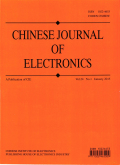- 钛学术文献服务平台 \
- 学术期刊 \
- 工业技术期刊 \
- 无线电电子学与电信技术期刊 \
- 中国电子杂志(英文版)期刊 \
Methodology of Efficient Energy Design for Noisy Deep Submicron VLSI Chips
Methodology of Efficient Energy Design for Noisy Deep Submicron VLSI Chips
基本信息来源于合作网站,原文需代理用户跳转至来源网站获取
摘要:
Power dissipation is becoming increasingly important as technology continues to scale. This paper describes a way to consider the dynamic, static and shortcircuit power dissipation simultaneously for making complete, quantitative prediction on the total power dissipation of noisy VLSI chip. Especially, this new method elucidates the mechanism of power dissipation caused by the intrinsic noise of deep submicron VLSI chip. To capture the noise dependency of efficient energy design strategies for VLSI chip, the simulation of two illustrative cases are observed. Finally, the future works are proposed for the optimum tradeoff among the power, speed and area, which includes the use of floating-body partially depleted silicon-on-insulator CMOS technology.

推荐文章
金黄色葡萄球菌CHIPS研究进展
趋化抑制蛋白
金黄色葡萄球菌
中性粒细胞
单核细胞
德国版智能电网“E-Energy”
智能电网
E-Energy
能源互联网
分布式能源
Deep web接口查询能力估计
查询接口
查询能力
Deep Web数据源自动分类
Deep Web
查询接口
朴素贝叶斯分类
内容分析
关键词云
关键词热度
相关文献总数
(/次)
(/年)
引文网络
引文网络
二级参考文献 (0)
共引文献 (0)
参考文献 (0)
节点文献
引证文献 (0)
同被引文献 (0)
二级引证文献 (0)
2004(0)
- 参考文献(0)
- 二级参考文献(0)
- 引证文献(0)
- 二级引证文献(0)
研究主题发展历程
节点文献
VLSI
能量损耗
CMOS
集成电路
动态电路
电路噪声
研究起点
研究来源
研究分支
研究去脉
引文网络交叉学科
相关学者/机构
期刊影响力
中国电子杂志(英文版)
主办单位:
出版周期:
季刊
ISSN:
1022-4653
CN:
N
开本:
出版地:
北京165信箱
邮发代号:
创刊时间:
语种:
eng
出版文献量(篇)
1919
总下载数(次)
1
总被引数(次)
318
期刊文献
相关文献
推荐文献
- 期刊分类
- 期刊(年)
- 期刊(期)
- 期刊推荐
一般工业技术
交通运输
军事科技
冶金工业
动力工程
化学工业
原子能技术
大学学报
建筑科学
无线电电子学与电信技术
机械与仪表工业
水利工程
环境科学与安全科学
电工技术
石油与天然气工业
矿业工程
自动化技术与计算机技术
航空航天
轻工业与手工业
金属学与金属工艺
中国电子杂志(英文版)2019
中国电子杂志(英文版)2015
中国电子杂志(英文版)2013
中国电子杂志(英文版)2012
中国电子杂志(英文版)2011
中国电子杂志(英文版)2010
中国电子杂志(英文版)2009
中国电子杂志(英文版)2008
中国电子杂志(英文版)2007
中国电子杂志(英文版)2006
中国电子杂志(英文版)2005
中国电子杂志(英文版)2004
中国电子杂志(英文版)2003
中国电子杂志(英文版)2001

 免费查重
免费查重










